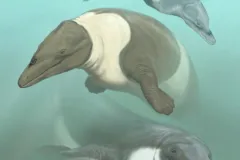New Archaeocetes from Peru Are the Oldest Fossil Whales from South America

The evolution of whales represents one of the great stories in macroevolution. It's a narrative that has mostly benefitted from an extraordinary series of fossils recovered from rocks around the world, including challenging field areas in Egypt, Pakistan, and India.
Over the past 30 years, the diligent work of many paleontologists has revealed a sequence of evolutionary transformations, between ~52 to 40 million years ago, which illuminate how the ancestors of today's whales adapted to life in the water from their terrestrial ancestors.
Interestingly, the near entirety of the fossil record of these early whales (also known as "archaeocetes") is documented from the Northern Hemisphere. In part to remedy this situation, starting in 2006, George Mason University professor Mark D. Uhen and I, along with other collaborators, conducted fieldwork in rocks of the Pisco Basin of Peru (below, left). This vast, sparsely vegetated desert in the southern part of Peru is widely known for its amazing fossil marine vertebrates (e.g., sharks, extinct marine sloths and extinct walrus-convergent dolphins) from younger rocks of the Pisco Formation. Instead, we focused our efforts on older rocks of the Paracas Formation, which have recently yielded remarkable giant penguins of Eocene age (an epoch spanning 56 to 34 million years ago).
Our team discovered three different kinds of archaeocetes from strata several dozens of meters below a volcanic ash bed. Volcanic ash is especially useful for geochronologic dating, which allowed us to determine a minimum age estimate with high precision using the sophisticated laboratory setup at the Berkeley Geochronology Center. As a result, we knew that the fossil whales we discovered were no younger than 36.61 million years old, and likely a few million years older.
After returning the fossils to the vertebrate paleontology department at the Museo de Historia Natural de San Marcos in Lima, we prepared the bones away from the rock matrix using mechanical drills, dental picks, and good ol' fashioned elbow grease (below, right). We made measurements of the bones, recorded key observations about their morphology, took photographs, and purchased new collections cabinets for the museum to house the specimens.
When we studied the evolutionary relationships among these specimens, we discovered that the three specimens represented two different types of archaeocetes.
One specimen, which we described but did not give a scientific name, was a protocetid. This group of archaeocetes (which includes Maiacetus, on display in the Sant Ocean Hall) possessed four, full limbs, suggesting a semi-aquatic lifestyle.
The other two specimens belonged to basilosaurids, a group that includes the long Basilosaurus skeleton also hanging in the Ocean Hall. We named the smaller of the new basilosaurids Ocucajea picklingi, after the town of Ocucaje, near where the fossils were discovered in the Ica desert, and to honor one of our esteemed Peruvian collaborators, José Luis Píckling Zolezzi. We named the other larger basilosaurid Supayacetus muizoni, after the Incan god of death and lord of the underworld, and after Dr. Christian de Muizon of the Muséum National d’Histoire Naturelle in Paris, honoring his longtime contributions to South American paleontology.
Not only do the new fossil represent new branches in the early cetacean family tree, they suggest an interesting story about Eocene oceans and the early evolution of whales at that time.
First, the rocks in which these archaeocetes were found show signs that the Eocene sea off the coast of Peru was relatively cool, a finding that differs from environmental reconstructions of most other archaeocete sites in the world. Such cool water currents, in today’s world, are often productive, and can support a wide variety of oceanic predators.
Second, the presence of both protocetids and basilosaurids off the Peruvian coast in the late Eocene tells us that early whales were able to disperse widely across the world prior to evolving completely pelagic features. Fossils of protocetids from the southeastern United States had already suggested this fact, but these fossils from South America provide even more support for the ability of early whales to roam (and swim) across oceans and continents.
This research was supported with funding from the University of California Museum of Paleontology, the Smithsonian Institution, the National Science Foundation and the Natural Sciences and Engineering Research Council of Canada.
Editor's Note: Dr. Pyenson's paper, "New Middle Eocene Whales from the Pisco Basin of Peru," appears in the September 2011 issue of the Journal of Paleontology. Explore a timeline of whale evolution in the Ocean Portal online interactive “Did Whale Evolution Go Backwards?”




